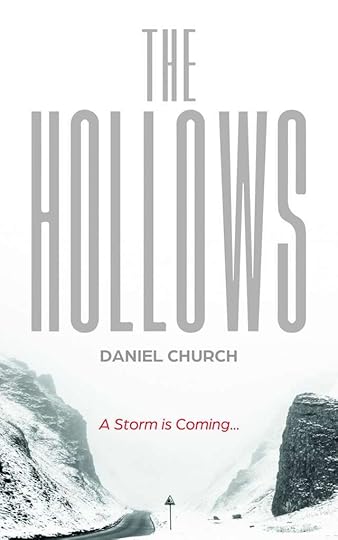Adrian Collins's Blog, page 131
July 14, 2022
REVIEW: Mech Armada
I’ve always appreciated the Early Access program for gaming, even if it has some problems attached to it. Sure, people may not like the idea of paying for an incomplete, in-development product, but I enjoy the process. I’ve previously worked in the gaming industry as a writer as well as a QA tester, so I’ve seen things on both sides of the coin. I get to try games out as they are in progress and offer feedback, and I’ve very rarely been burned by it. It’s always a good idea to do some solid research into the game in question. My tip? Buy the game for what it is now, rather than what might come in the future.
While the stigma for the Early Access program remains, there have been incredible successes in recent years. Satisfactory, Rimworld, Kenshi, Factorio, Kerbal Space Program, and Stardew Valley are just a few, and I’m barely scratching the surface. I wanted to discuss another one that recently left Early Access: Mech Armada. From humble beginnings, it’s rapidly become one of my favorite games. Hopefully, by the end of this, you guys might be willing to try it out!
IntroductionLaunching August 2021 in Early Access, Mech Armada grew strength to strength. In an apocalyptic world where monsters threaten to destroy humanity, you command the last bastion of resistance with help from a weird scientist, building an army of mechs to fight them. It’s a little like Pacific Rim, I suppose. It’s a turn-based roguelike with a torrent of customization. The number of options available to the player is staggering.
I’ve always loved the idea of creating combat units from scratch. There was an amazing RTS game in the 2000s called Impossible Creatures which allowed you to mix combat animals with thousands of combinations, and Mech Armada is the closest game to scratch that itch. There are plenty of mech parts to unlock and swap, and there is so much to dig into it can be overwhelming.
The BasicsIt’s a simple game to look at. The visuals and battlefields aren’t anything special, but they get the job done. I have no complaints, and the interface is solid. I never got confused about what I needed to do. Despite how many options are available, the game can get pretty difficult. I struggled at first, especially with the varied enemies because they really test the player. Got a load of mechs that specialize in long-range combat? The Dodger insects will ruin their day with their immunity to anything that isn’t close combat. There are tons of different enemy types and big boss battles during its significant campaign mode, which provides a lot of content from the beginning. While I admit I’m not particularly good at the game, it’s satisfying to play, and I never got frustrated.

The diverse number of enemy types make for puzzles. Which unit will perform the best?
Over its development, Mech Armada saw several improvements in optimization as well. At launch, the game was a little unstable and I experienced plenty of bugs, crashes, and a high laptop temperature, despite its small graphical footprint. This has mostly been fixed as of the full release, with CPU temps lowered significantly too. This isn’t a game that will push a system very hard, so most systems will run it! There was a game mechanic originally in the game involving a black fog that kills instantly: designed to encourage the player to attack aggressively. While this was good in theory, the small map sizes at launch made this frustrating rather than an additional strategic layer. The launch version has removed this mechanic for the first Act of the game, providing more story to it.
The progression of Mech Armada is always entertaining. Every run will unlock more points, which provide new parts and tools to bring into the game. Building mechs and swapping out different parts will bring plenty of strategy into the game, especially with the free building mode that’s recently available: You can now change your mechs whenever at the cost of energy. Oh yeah, energy siphons are used to build and summon the units. The more they cost, the harder they are to replace. Upgrading parts with machine pieces brings plenty of diversity.
One of my favorite units was a double minigun teleport boat: it did a massive amount of damage on the battlefield, but it was very expensive and couldn’t take a hit. Recent economy upgrades have balanced the game and made it more dynamic. In the past, mech parts were unlimited so it was easy to min-max a group for a campaign, but now, parts have limited uses to encourage a greater diversity of designs. I prefer that.

My giant army of mechs, ready to take on the world.
Recent UpdatesMech Armada also contains a powerful sandbox mode, a major update around Christmas time which greatly improves the game. In this run, there’s access to every single part unlocked so far: being able to start at any part of the game, customize starting resources, and just have a blast with greatly increased limits. Games need more sandbox modes, and sometimes it’s nice to kick back and relax. This is my most enjoyable game mode in Mech Armada. It’s always worth keeping a sandbox save around to experiment with builds and designs.
One of the largest updates Mech Armada received was in February. While I was having plenty of fun with the game before, the gameplay loop felt fairly linear. It was a collection of monster battles with a boss battle at the end of every stage, but it could use more variety. The new Campaign map fixed all of these issues, with different paths available to the player! There is now a choice of two boss fights per stage, and different paths provide different challenges and additional bonuses. For example, one path may provide more parts and weapons, or another path may give the player extra energy. That can sometimes mean more dangerous fights, but the added dynamics of choosing your own path greatly improve the experience.

The Campaign map grants plenty of different paths to take.
ConclusionOverall, there’s a lot to recommend in Mech Armada. With its 1.0 release, I’m happy to see success for the developer. For its price point, it’s almost asking too little money for what it offers. I would love to see mod support included at some time in the future: the ability to create enemies, weapon parts, and maps would add unlimited potential.
Mech Armada is available on Steam, and you can pick it up here for around 20USD/£17.99/19 EUR https://store.steampowered.com/app/1389360/Mech_Armada/
Score: 4 Stars (Highly Recommended and a solid tactical roguelike game)
The post REVIEW: Mech Armada appeared first on Grimdark Magazine.
REVIEW: A Clash of Kings by George R.R. Martin
A Clash of Kings, George R.R. Martin’s epic second volume of A Song of Ice and Fire, is a masterclass in grimdark fantasy, somehow improving upon the already excellent first volume, A Game of Thrones, in every respect. Having already established the key characters in A Game of Thrones, A Clash of Kings jumps right into the action and never lets up.
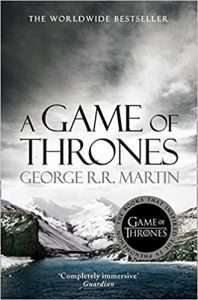 The scope of A Clash of Kings is enormous: six warring families, all vying for power following the deaths of King Robert Baratheon and Lord Eddard Stark. The battles and strategic maneuvering among the six families are accompanied by a healthy dose of intrafamily drama and betrayal.
The scope of A Clash of Kings is enormous: six warring families, all vying for power following the deaths of King Robert Baratheon and Lord Eddard Stark. The battles and strategic maneuvering among the six families are accompanied by a healthy dose of intrafamily drama and betrayal.
Although the storylines are sprawling, they work so effectively because they are presented from the eyes of a vibrant cast of well-realized characters. All the same point-of-view characters from A Game of Thrones are retained in A Clash of Kings, except for Eddard Stark. There are also two additions: Theon Greyjoy and Ser Davos Seaworth. Theon is the more interesting of the two, and his sister, Asha Greyjoy, is a delight.
Davos serves more as a vehicle for learning about King Robert’s brother, Lord Stannis Baratheon, who declares himself to be the rightful King of Westeros. These chapters also introduce us to Melisandre, a red priestess and powerful shadowbinder in the service of Lord Stannis. She is one of the most fascinating new characters in A Clash of Kings, bringing additional elements of magic to the story.
The real star of A Clash of Kings is Tyrion Lannister, who has been appointed by his father to serve as Hand for King Joffrey. Over the course of fifteen chapters, Tyrion becomes the most fully realized character in the series so far. Ever witty and insightful, Tyrion is a cunning master at political maneuvering, especially in the face of his sister, Queen Cersei. Tyrion also has a warm heart. His love for Shae is especially touching, as are his attempts to protect Sansa Stark.
Poor Sansa. She is betrothed to the temperamental boy-king Joffrey, who abuses her both physically and psychologically. Sansa is essentially a hostage and used as a bargaining chip for the Lannister family in trying to free Jaime Lannister. Although presented as a rather superficial character in A Game of Thrones, Sansa grows a lot during A Clash of Kings and starts to see how she is being manipulated by the Lannisters.
Sansa’s younger sister, Arya, is given significantly more focus in A Clash of Kings compared to the previous book. Arya has escaped the clutches of the Lannister family and now assumes various false identities as she attempts to find her way back to her own family. Arya spends much of the book disguised as a peasant boy, Arry, trying to survive in the cruel world of Westeros.
Meanwhile, Bran Stark oversees Winterfell while his brother Robb, now King of the North, is leading their military campaign. Bran has developed a mental bond with his direwolf, Summer, giving him unusually realistic dreams from the direwolf’s perspective. He soon learns that the bond with Summer is much deeper than originally thought.
Further north, Jon Snow helps lead the Night Watch’s exploration beyond the Wall to investigate the disappearance of several rangers, including Benjen Stark. Like Bran, Jon develops a powerful bond with his direwolf, Ghost, enabling him to control the direwolf’s actions.
Of the main characters established in A Game of Thrones, Daenerys Targaryen is the only one given significantly less page time in A Clash of Kings. Daenerys has named her baby dragons after her deceased husband and brothers and spends most of A Clash of Kings laying the groundwork for an eventual return to power in Westeros.
A Clash of Kings is a feast for grimdark fans, masterfully building upon the already strong foundation of A Game of Thrones while taking the story and characters to new heights.
5/5
Read A Clash of Kings by George R.R. MartinThe post REVIEW: A Clash of Kings by George R.R. Martin appeared first on Grimdark Magazine.
July 13, 2022
REVIEW: The Tyrant’s Law by Daniel Abraham
The Tyrant’s Law, the 3rd entry in Abraham’s The Dagger and the Coin series, is another steady and enjoyable epic fantasy read. It increases the stakes and drama, adding layers to the flourishing world-building whilst not quite being up to the same high standards as The King’s Blood. The events of The King’s Blood were wrapped up neatly so – in The Tyrant’s Law – it seems like new tales are beginning or critical next steps in a character’s journey are taking place.
 The titular “tyrant” Geder Palliako is still, arguably, my favourite character, and when I started this read, I thought that was a rather unflattering word for him. He’s a highly complex individual, and as his insecurities and frailties are revealed to us, his reputation, renown, and awe-inspiring skill for thwarting conspiracies grow to the observing characters. The “tyrant” title does become more understandable as the narrative progresses, however; due to us seeing his precarious uncertainties – as we’re sharing his thoughts – I can’t help but sympathise with him. He’s overwhelmed, paranoid, and has the blessing of the Spider Goddess all to contemplate. As the novel progresses so does Geder’s instability.
The titular “tyrant” Geder Palliako is still, arguably, my favourite character, and when I started this read, I thought that was a rather unflattering word for him. He’s a highly complex individual, and as his insecurities and frailties are revealed to us, his reputation, renown, and awe-inspiring skill for thwarting conspiracies grow to the observing characters. The “tyrant” title does become more understandable as the narrative progresses, however; due to us seeing his precarious uncertainties – as we’re sharing his thoughts – I can’t help but sympathise with him. He’s overwhelmed, paranoid, and has the blessing of the Spider Goddess all to contemplate. As the novel progresses so does Geder’s instability.
Marcus Wester and Master Kit’s tale – although taking a backseat in The King’s Blood – is driven to the forefront of the focus in The Tyrant’s Law, and I had so much time for that! Their adventures and escapades take them across half the world, with a fair amount of memorable and cinematic moments happening to them. Their overall importance and knowledge regarding which side they may be fighting for during this war become more apparent, and I couldn’t help chuckling to myself thinking that much of their actions were alike quests from The Elder Scrolls: Skyrim. Their screentime was often unlike, and a pleasant change in pace from, the more political undertakings of Geder, Clara, and the financial and political happenings of Cithrin bel Sarcour’s point of view perspectives.
“The world disappoints us all, and the ways we change our own stories to survive that disappointment are beautiful and tragic and hilarious. On balance, I find much more to admire about humanity than to despise.”
There are no weak point of view perspectives in The Tyrant’s Law. As you can see, I’ve already written about half a review just discussing two of them. Cithrin is still an amazing character and the reason I said “arguably” when I described Geder as my favourite, as, at some instances, it could be her too. Clara’s chapters show a side of the Capital that we weren’t privy to in the first two books, reflecting her fall from grace. War and horrid happenings feature throughout this novel but I felt that Clara’s chapters had a dark, high-stakes edge, where any page could ooze either violence, degradation, disruption, manipulation, or stark loyalty. Hers is another arc that weaves a complex and multifaceted presentation that just feels pretty special.
“Find competent, trustworthy servants, treat them with respect, and let them do their work. Listen when spoken to. Remember everybody’s name and something about the peculiarities of their lives. Forgive any mistake once, and none twice.”
In my previous reviews, I haven’t really talked too much about The Dagger and the Coin’s world-building. Before this novel, the series’ world-building seemed like interesting sprinkles and sparkles of information here and there, either through dialogues, plays, or historical texts, which tended to make it seem a fantasy tale rather than a political intrigue set of books. In The Tyrant’s Law, it’s as if these sprinkles and sparkles have finally settled, with more solid knowledge about The Dragon’s War given, enough information presented about the 13 races of humanity, and as some of the mysteries surrounding The Spider Goddess have become unshrouded. These neat moments and nuances have now been artfully fabricated to be of the utmost importance to the characters we follow in their current happenings.
There is a lot to admire in Abraham’s work. As mentioned, I didn’t enjoy this as much as the previous novel, but the author has moved the overall story forwards dramatically and multiplied the complexities and the stakes, again. This read was sitting at a steady and well-respected 3/5 stars but the fantastic endings move it up to 3.5/5. The Dagger and the Coin is bulging with potential and many wonderful elements. The series could be about to transcend and become something truly spectacular. I’m hopeful that The Widow’s House carries on doing what this series has done so well so far, and directs it to an engaging and breathtaking next level.
Read The Tyrant’s Law by Daniel Abraham“Gifts create a sense of obligation,” she said. “Not debt, exactly, because it can’t be measured. And because it can’t be measured, it can’t be definitively repaid. If instead you’d given me the coin you spent to buy that, I’d know what I owed, and I could give it back and be done. By giving me a gift instead, you build the sense of owing without a path to repayment, and so I’m more likely, for example, to grant you a favor or make some concession that I’d never have agreed to if I’d been given an explicit price.”
The post REVIEW: The Tyrant’s Law by Daniel Abraham appeared first on Grimdark Magazine.
July 11, 2022
REVIEW: Wrath Goddess Sing by Maya Deane
Wrath Goddess Sing by Maya Deane is a hard book to review. It is a book that it is more than the sum of its parts – a retelling of the Illiad featuring Achilles as a trans woman, written by a trans woman author. It is a first, certainly for traditional publishing. It also departs from the story as we know it from Homer in many ways, some more recognizable than others, making Wrath Goddess Sing not always easy to situate. While I thoroughly enjoyed the book as a whole, especially the gorgeous, evocative writing, taking it apart into individual elements and considering those made me feel a lot more ambiguous about the book. And that really is one of the biggest challenges as a reviewer. Do we reward taking risks, do we look at the whole and the impact that the publication will have on the landscape and push the ideas behind the book perhaps more than the sum of its part, the execution as it may be? Does reviewer behaviour affect how willing these same editors and publishers may be to take similar risks in the future, as a part of the industry who care about its development or should we be the ultimate impartial instance, treating all books exactly the same, no matter their context? I have to admit, I do lean towards the former, wanting to support traditional publishing branching out of their safe spaces, taking risks, publishing books that will garner discussion and may not be immediate bestsellers.
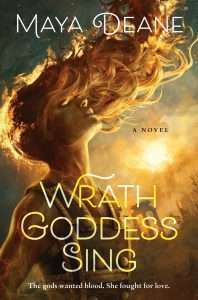 Wrath Goddess Sing takes the infamous part of the Illiad where Achilles hides among the Kallai, dressed up as one of the maidens, and asks the question: What if it’s not a costume? And for me, that was such a lightbulb moment. I had always felt uncomfortable with this part of the story, as I have with many narratives that feature characters dressing up as a different gender, but not interrogating gender identity. From there, we are taken on a mostly familiar journey – though this isn’t a straight retelling. Maya Deane takes the stories from the Iliad and weaves them into a new tapestry, which is both intriguing and at the same time slightly irritating to the reader. Given that the story, as a retelling, already has a hook that makes it a new tale, I found that especially the changed names of familiar characters and places threw me off. For example, Paris was named Aleksandu here, and Troy Wilusa. This often made me feel like Wrath Goddess Sing may have been better off – and possibly received better – as a fully self-contained fantasy novel, rather than as one based on earlier mythology.
Wrath Goddess Sing takes the infamous part of the Illiad where Achilles hides among the Kallai, dressed up as one of the maidens, and asks the question: What if it’s not a costume? And for me, that was such a lightbulb moment. I had always felt uncomfortable with this part of the story, as I have with many narratives that feature characters dressing up as a different gender, but not interrogating gender identity. From there, we are taken on a mostly familiar journey – though this isn’t a straight retelling. Maya Deane takes the stories from the Iliad and weaves them into a new tapestry, which is both intriguing and at the same time slightly irritating to the reader. Given that the story, as a retelling, already has a hook that makes it a new tale, I found that especially the changed names of familiar characters and places threw me off. For example, Paris was named Aleksandu here, and Troy Wilusa. This often made me feel like Wrath Goddess Sing may have been better off – and possibly received better – as a fully self-contained fantasy novel, rather than as one based on earlier mythology.
On social media, this novel has been called out for including depictions of slavery, specifically of a trans man depicted as dark-skinned. While I have to admit that I missed this when I read the book (I’m afraid that I don’t always pay attention to visual descriptions as someone with aphantasia), the way in which the story departs from what the reader might expect from the period and known stories, makes me wonder whether this is not an element that could have been avoided. But then, slavery was a part of society within the context of the time, and as that, is not something that we should be considering under modern morals, but rather those of the period.
I found the varying dynamics among the trans women in the story fascinating – and while some parts made me deeply uncomfortable (while I’m queer, I’m not a trans woman), I do defer to Maya Deane, who is writing informed by her own perspective. I am looking forward to the book being out for a while and hearing nuanced takes on these parts from the trans community specifically, as while these experiences are not universal, I think there are valuable points to be made and taken from here.
As a whole, the book is utterly bonkers, full of godly intrusions and strong characters who are determined to shape the world along their will. It is, in many ways, a great book, and one that will – and already has, in my communities – start discussions. The writing stands out and draws the reader in, creating a unique book and one I will think about for a long time to come.
Read Wrath Goddess Sing by Maya DeaneThe post REVIEW: Wrath Goddess Sing by Maya Deane appeared first on Grimdark Magazine.
July 10, 2022
Grimdark Magazine Issue #31 is here!
In Grimdark Magazine Issue #31, I am very proud to bring you what I hope is a range of new voices you’ve yet to read before amongst new ideas from authors you already know and love. Inside, you’ll find grim and gritty stories from new points of view, plot twists that leave your jaw dangling against your sternum, and articles and interviews that hopefully get your thinking skullcaps warmed up.
But first, as always, let’s glory in another Carlos Diaz cover, this time based on Richard Swan’s Empire of the Wolf story, A Reputation for Prudence.
The cover for Grimdark Magazine Issue #31I’m not going to lie, since day one I’ve been wanting to have a character launched out of a window. A tip of the pint glass to Richard Swan for giving me that opportunity!
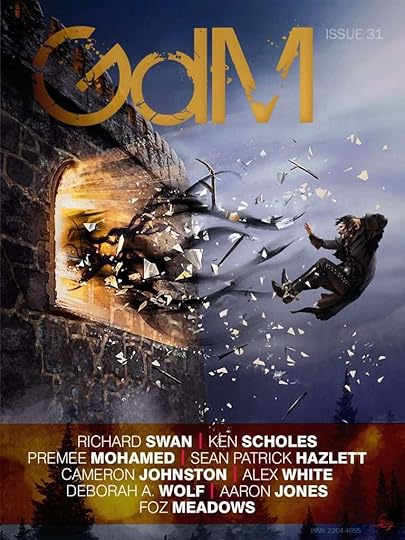
Grimdark Magazine presents the darker, grittier side of fantasy and science fiction. Each quarterly issue features established and new authors to take you through their hard-bitten worlds alongside articles, reviews and interviews. Our stories are grim, our worlds are dark and our morally grey protagonists and anti-heroes light the way with bloody stories of war, betrayal and action.
FictionAnd Sneer of Cold Command by Premee MohamedThe First Bar at the End of the Day by Ken ScholesHead Games by Cameron JohnstonAdramelech by Sean Patrick HazlettA Reputation for Prudence by Richard SwanNon-fictionAn Interview with Foz Meadows (interviewed by Beth Tabler)Royalty and Power in Fantasy: Heavy is the head that wears the crown by Aaron S. JonesAn Interview with Chris Panatier (interviewed by Beth Tabler)Associating with Antiheroes by Deborah A WolfReview: August Kitko and the Mechas from Space by Alex White (review by Beth Tabler)Writing Good Tie-in Fiction by Alex WhiteRead Grimdark Magazine Issue #31Grab your copy from our online store, or using the links below. For our Patreon subscribers, your issue awaits you in your Patreon inbox! Please also add our Goodreads entry for this issue to your shelves.
Beth Tabler taking the reigns of Issue #32, onwards!After 31 issues of Grimdark Magazine over eight years I am also very proud to have Beth Tabler taking over the reins for fiction and article procurement for Issue #32 onwards. Over the last year and a half, Beth has been getting more and more involved in issue publication. You’ll see her name against pretty much every interview, she’s been procuring more and more stories and articles, and she’s been learning the nuts and bolts that go into creating every quarterly issue of this ezine. Please join me in giving her a crisp shield clash and some appreciative side-eye (with only a minor side of intention-to-betray) as she continues to deliver what you love to read.
And what will this lazy old goat be doing? While I’m supporting Beth and the online content team, I’ll be focussing on larger publishing projects like Evil is a Matter of Perspective, The King Must Fall, and In the Shadow of their Dying. What does that mean for you? More grimdark fiction and content, of course!
For now, happy reading, and as always, thank you for your support.
The post Grimdark Magazine Issue #31 is here! appeared first on Grimdark Magazine.
July 9, 2022
REVIEW: Nona the Ninth by Tamsyn Muir
Book three in Tamsyn Muir’s brilliantly strange The Locked Tomb series was originally supposed to be Alecto the Ninth but somewhere along the way plans changed, the trilogy became a series, and Nona the Ninth came into being – another mind-bending but deeply compelling tale of necromancers, cavaliers, the Nine Houses…and a sweet-natured girl with golden eyes. Set six months after the events of Harrow the Ninth, it sees Muir double down on what now feels like her standard practice of confounding expectations and delivering something nobody expected. In this case that means Nona, who may only be six months old but inhabits a nineteen year-old body that probably doesn’t belong to her, living in a war-torn city with three people who share two bodies, and working as a Teacher’s Aide in a school full of strangely-named children (and Noodle the dog). Got all of that?
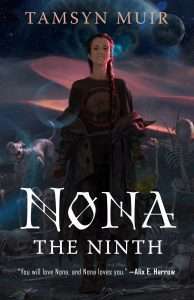 As you might expect, this isn’t a straightforward, easy book. It starts off pretty slow, contrasting Nona’s point of view with strange, revelatory dream segments, and it quickly becomes clear that while this definitely feels like a natural continuation of the series, it very much has its own tone. Nona’s voice is utterly different to Gideon’s or Harrow’s – she’s wonderfully sweet and innocent, but also strangely intense, which is unsurprising given that she’s essentially a child living in a borrowed body, who’s grown (and is in fact still growing) up in a warzone, remarkably comfortable with the violence and poverty all around her. There are, of course, rather uncomfortable parallels to be drawn with the real world in this respect, and as the book progresses it explores the history of the Locked Tomb setting in a way that links it to reality in an unexpected, but very effective fashion.
As you might expect, this isn’t a straightforward, easy book. It starts off pretty slow, contrasting Nona’s point of view with strange, revelatory dream segments, and it quickly becomes clear that while this definitely feels like a natural continuation of the series, it very much has its own tone. Nona’s voice is utterly different to Gideon’s or Harrow’s – she’s wonderfully sweet and innocent, but also strangely intense, which is unsurprising given that she’s essentially a child living in a borrowed body, who’s grown (and is in fact still growing) up in a warzone, remarkably comfortable with the violence and poverty all around her. There are, of course, rather uncomfortable parallels to be drawn with the real world in this respect, and as the book progresses it explores the history of the Locked Tomb setting in a way that links it to reality in an unexpected, but very effective fashion.
While Nona is quietly content with her life, her companions – Camilla, Palamedes and Pyrrha (it all makes sense … eventually, I promise) – have a different view of things. As the book is written from Nona’s perspective, we as readers only get to see what Nona sees, all of which is filtered through her strange level of knowledge and understanding. Muir takes her time letting details trickle through and along the way raises a lot of questions – what these characters are actually doing, where other important characters from previous books are at this point in the narrative, what that big blue light in the sky is, why Noodle (the dog) has six legs, and – most importantly – what the hell is actually going on. Much like Harrow, while not every question gets an obvious answer, it does all come together in time.
You might consider this something of a setup book, laying the groundwork for the dramatic series finale still to come, but that would be unkind to Nona the Ninth and would ignore the depth and context that Nona’s story offers to the setting and the ongoing narrative. It expands the scope of the series in a way we haven’t seen before, not only giving us a new perspective into the world, but offering an unexpected origin story of sorts – on the Nine Houses, on the Lyctors, on God/John Gaius, and more – and providing a fair few “wait, what?!” moments that are bound to provide considerable talking points for fans. Crucially, Muir finds an effective balance between helping readers understand what’s going on and allowing the story to retain a degree of mystique.
What Nona the Ninth won’t do is change anyone’s mind on the series as a whole; readers who struggled with Harrow, for example, may not find this much easier, and Muir is unapologetic in her determination to tell this story in her own fashion. It is, in its own way, a strange and confusing book which demands trust from the reader, requiring the reader to process a lot of new names and take a lot on faith, with very little in the way of obvious narrative signposting.
Those who have loved both Gideon and Harrow will likely find a lot to enjoy in Nona though, from Nona’s weird but brilliantly drawn friends to some intriguing observations on identity, purpose, loss and sadness. Almost every character here has lost something or someone, and the different ways in which they deal with that provide a powerful emotional kick to the story alongside the eventual implications of its twisty, unexpected plot. Nona the Ninth may not be what you expected, but it might just be what you need. Just … make sure you’re really clear on what’s happened so far in the series (a re-read of the first two books is well worth it), and don’t expect any easy answers!
Huge thanks to Tordotcom and Tamsyn Muir for sending me an advance copy of Nona the Ninth in exchange for my honest opinions.
Read Nona the Ninth by Tamsyn MuirThe post REVIEW: Nona the Ninth by Tamsyn Muir appeared first on Grimdark Magazine.
REVIEW: The Butterfly Garden by Dot Hutchison
Dot Hutchison’s The Butterfly Garden is a dark masterpiece, a disturbing psychological thriller and gruesome crime novel overlaid with a relentless sense of horror. All these elements come together fluidly in this exceptionally well-written book that is full of suspense and unnervingly dark plot twists.
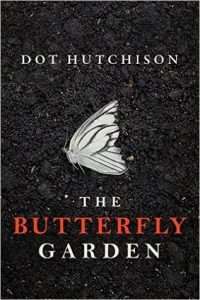 The plot of The Butterfly Garden involves a group of girls who are kidnapped and held captive by a deranged wannabe lepidopterist known only as the Gardener. The Gardener tattoos giant butterfly wings onto the backs of the unwilling girls and rechristens them with new names as they are imprisoned in his secret butterfly garden.
The plot of The Butterfly Garden involves a group of girls who are kidnapped and held captive by a deranged wannabe lepidopterist known only as the Gardener. The Gardener tattoos giant butterfly wings onto the backs of the unwilling girls and rechristens them with new names as they are imprisoned in his secret butterfly garden.
This is only the beginning of the horrors that the girls will encounter at the hands of the Gardener and his even more sadistic firstborn son in The Butterfly Garden. There is a glimmer of hope in the Gardener’s younger son, but will he have the courage to stand up to his elder brother and tyrannical father?
The story alternates between the first-person narration of Maya, one of the kidnapped girls and the main character of the novel, and Maya’s third-person interview with the FBI agents who are investigating the case. Dot Hutchison effectively uses these alternating first- and third-person narrative styles to maintain a heightened level of suspense throughout the novel, keeping the reader guessing until the very end.
Maya is an outstanding narrator, full of dark wit and keen insights. There is also a specter of potential Stockholm syndrome hanging over her narration as the true horrors of the butterfly garden are gradually revealed.
Maya’s account of the events in the butterfly garden are interspersed with stories of her troubled family background. It is especially interesting to see how Maya’s experiences as a child shaped her approach for surviving abduction and caring for the other imprisoned girls.
The Butterfly Garden is the first volume of Dot Hutchison’s series, The Collector. Rather than continuing with Maya, the subsequent books in the series follow the same set of FBI agents as they investigate new cases. While Maya is a very well-developed character, I didn’t feel any particular attachment to the FBI agents in The Butterfly Garden, since they are basically vehicles allowing Maya to tell her story. Given this choice, I’m curious to see how Dot Hutchison takes this series forward.
Overall, The Butterfly Garden is top-notch horror that explores the depths of human cruelty, especially at the hands of an exceptionally disturbed and sadistic man who bestializes young women. After reading this novel, I will never look at butterfly gardens the same way.
5/5
Read The Butterfly Garden by Dot HutchisonThe post REVIEW: The Butterfly Garden by Dot Hutchison appeared first on Grimdark Magazine.
July 8, 2022
REVIEW: The Hedge Witch by Cari Thomas
The latest offering from the Sunday Times bestselling author Cari Thomas is her novella The Hedge Witch. Set in her Threadneedle world, The Hedge Witch appears earlier in The Language of Magic chronology than the novel Threadneedle and focuses on the character of Rowan. I believe that readers could easily pick up and enjoy The Hedge Witch with no prior knowledge of Thomas’ rich world. It gives a lovely taste of her writing style and the magics of Threadneedle without the reading commitment of a full size novel. Also, if you read and enjoyed Threadneedle, then The Hedge Witch will be a superb way to return to this realm and learn more about Rowan and the magic of the hedge witches. I would like to thank Harper Voyager and Cari Thomas for sending me an electronic Advanced Reader Copy of The Hedge Witch so that I can review the novella for Grimdark Magazine.
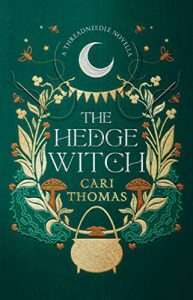 I enjoyed The Hedge Witch and think it was an entertaining read. I will not however be giving it a numerical rating, as like other short fiction such as The Slow Regard of Silent Things, it is not really in the grimdark wheelhouse so would not feel fair to apply one in this instance. The Hedge Witch was a nice sojourn into a whimsical fantasy world, and felt to me quite like a palate cleanser – a refreshing literary bite, savoured in between some epic grimdark tomes. I think it may appeal to some of Grimdark Magazine’s readers as lighter escapism but if they are looking for a gritty, twisted, and morally ambiguous novella then this is not the choice to make.
I enjoyed The Hedge Witch and think it was an entertaining read. I will not however be giving it a numerical rating, as like other short fiction such as The Slow Regard of Silent Things, it is not really in the grimdark wheelhouse so would not feel fair to apply one in this instance. The Hedge Witch was a nice sojourn into a whimsical fantasy world, and felt to me quite like a palate cleanser – a refreshing literary bite, savoured in between some epic grimdark tomes. I think it may appeal to some of Grimdark Magazine’s readers as lighter escapism but if they are looking for a gritty, twisted, and morally ambiguous novella then this is not the choice to make.
Set in a modern day magical world, The Hedge Witch follows Rowan on a summer visit to relatives in a small town, nestled in the Welsh countryside, before she starts sixth form. This places Rowan in her mid-teens and the themes of the novella match her age, with Rowan trying to fit in, make friends, assert her independence etc. The Hedge Witch does not have the same urban setting or bildungsroman nature of Threadneedle but it has the same magical concepts and I liked learning more about the plant based magic that The Hedge Witch focuses on.
At just shy of one hundred and fifty pages, The Hedge Witch is an engaging and well-constructed novella. It is marketed as an “adult” fantasy but as with Threadneedle there is nothing content wise that might make me wary of suggesting it to fans of the “young adult” fantasy genre. There are not for example any violent or sexual scenes and any swearing is shown through magical curse words. There are some very humorous moments in the novella and the magical mystery arc held my interest, as did the supernatural elements. I think that some of the minor characters were a little two dimensional, but it would be hard to flesh out and thoroughly develop numerous characters in a story of this size.
Overall I liked The Hedge Witch. I am fond of short fiction and being able to dabble my toes in an array of fantasy worlds without the commitment of novel many hundreds of pages long and The Hedge Witch gave me a few hours of nice charmed exploration. Although it was a little juvenile, I think that is to be expected when the main character is of that age and there is not a traumatic incident in the narrative forcing them to be more adult. Thomas has a straightforward writing style which I prefer when reading a novella but other readers may find it too simplistic. Based on the popularity of Thomas’ novel Threadneedle, The Hedge Witch will undoubtable have a lot of fans when it is released and if Threadneedle or similar coming of age teen witchy dramas are what you like then this is the novella for you.
Read The Hedge Witch by Cari ThomasThe post REVIEW: The Hedge Witch by Cari Thomas appeared first on Grimdark Magazine.
July 5, 2022
REVIEW: A Game of Thrones by George R.R. Martin
Life is full of insignificant events, small perturbations that are rarely of any consequence. But occasionally the conditions are right for a small perturbation to escalate into something that alters the entire world, leaving a permanent mark on history. Whether it’s the start of a World War or the beginning of a global pandemic, the impact of a single, seemingly insignificant event can grow to outsize proportions, pushing the world out of its delicate balance.
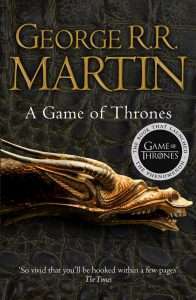 The same is true for A Game of Thrones, the first volume of A Song of Ice and Fire by George R.R. Martin. A society full of opposing political factions and personal deceit hangs precariously on the assumption that hidden duplicity remains behind its shroud of secrecy. But then a seemingly insignificant event shatters that illusion—a young boy climbs a wall and sees something that he shouldn’t see and doesn’t even understand.
The same is true for A Game of Thrones, the first volume of A Song of Ice and Fire by George R.R. Martin. A society full of opposing political factions and personal deceit hangs precariously on the assumption that hidden duplicity remains behind its shroud of secrecy. But then a seemingly insignificant event shatters that illusion—a young boy climbs a wall and sees something that he shouldn’t see and doesn’t even understand.
The impact of A Game of Thrones on the world of fantasy cannot be overstated. Its publication in 1996 brought about an irreversible step change in fantasy literature, which for decades had been following the blueprint laid out by J.R.R. Tolkien in The Lord of the Rings.
Since its release in the 1950s, The Lord of the Rings had become the single most influential work of fantasy ever written, spawning countless imitations, none of which could reach the same level of impact achieved by Tolkien. Tolkien’s cultural influence stretched far beyond the world of literature, encompassing cinema (Peter Jackson), music (Led Zeppelin), and any number of role-playing games, including both tabletop games like Dungeons and Dragons and video games such as the Final Fantasy series.
Tolkien combined expansive, detailed worldbuilding with an epic good-vs-evil struggle of biblical proportions. Although Frodo struggles mightily against the corrupting power of the One Ring, there is never any doubt that he is on the side of good, a Christ figure who is willing to sacrifice himself to save others. Only two notable characters in The Lord of the Rings exhibit discernable gray morality. The most obvious of these is Gollum/Sméagol, but his gray morality is just a superposition of two dichotomous personas, one of which is good (Sméagol) and the other evil (Gollum). The other character, of course, is Boromir, who is fundamentally good but ultimately seduced by the Ring, becoming the Judas Iscariot figure of the Fellowship.
In A Game of Thrones, George R.R. Martin embraced Tolkienesque worldbuilding while taking an antithetical approach to character morality. Both Middle-earth and Westeros feel authentic because they are so fully realized, complete with their own history and culture, giving the reader a fully immersive experience where they can suspend their own reality while diving into a richly detailed new world.
The main difference comes in the gritty approach that Martin has taken toward character morality, making A Game of Thrones one of the first true grimdark fantasies. Whereas Middle-earth is a world of black and white, Martin uses a full palette of gray to paint his cast of characters. If Tolkien has written an allegory for the epic battle of Christ vs Satan, then George R.R. Martin is more interested in the sneering Pontius Pilate, questioning the meaning of truth itself.
In presenting a grittier, more realistic approach to fantasy, A Game of Thrones became part of a larger cultural movement that emerged in the 1990s. For example, at around the same time, grunge bands such as Soundgarden and Alice in Chains came to prominence, bringing an unapologetic rawness and honesty to a music scene that, in the preceding decade, had been hiding behind a façade of synthetic sounds, big hair, and heavy makeup.
More than a quarter century later, A Game of Thrones has rightfully become one of the most respected and influential works of fantasy. A Song of Ice and Fire has sold close to 100 million books worldwide, becoming one of the best-selling series of all time.
Rereading A Game of Thrones, it’s easy to see why. George R.R. Martin is an outstanding writer. Given the complexity of the world and the plot, this book could have easily become unreadable in less capable hands. But Martin does a wonderful job introducing us to the characters and worldbuilding in a natural and accessible fashion. A Game of Thrones is never a chore, and the pacing is remarkably consistent throughout the book.
Although A Game of Thrones is fantasy, the magical elements are of secondary importance, at least in this first volume of A Song of Ice and Fire. Instead, A Game of Thrones is driven by its wonderful cast of characters. George R.R. Martin has crafted some of the finest characters in all of fantasy, including the inimitable Tyrion Lannister, whose astute political skills are coupled with a keen wit and a genuine kindness toward the less fortunate.
One of the interesting choices made by George R.R. Martin is that, out of the eight point-of-view characters in A Game of Thrones, five are children. Jon Snow and Daenerys Targaryen are both 14 years old at the beginning of A Song of Ice and Fire. Among the Stark children, Sansa is 11, Arya is 9, and Bran is 7. Beyond these point-of-view characters, Robb Stark is 14 and Joffrey Baratheon is 12. This may be surprising for fans of the HBO series, since all the actors portraying these characters were significantly older than the characters themselves. Considering their young age, the terrible situations experienced by these children in A Game of Thrones become all the more harrowing. I particularly admire the way Daenerys overcomes unspeakably terrible abuse to grow into the strong, self-assured leader that she becomes.
We are living the legacy of A Game of Thrones now, with its indelible impact on both grimdark fantasy and epic fantasy in general. One prominent example is The Way of Kings by Brandon Sanderson, which is clearly influenced by the narrative structure, expansive worldbuilding, and character-driven plot of A Game of Thrones. Both are full of political intrigue and focus on sparring factions of a fractured society who are fighting each other when they should be focused on a more sinister enemy posing an existential threat to their civilization.
Does this remind you of anyplace else? Although A Game of Thrones emerged in the 1990s, I would argue that it is even more relevant today in our own time wracked by political extremism and a breakdown of global order, where irrational nationalism trumps our ability to confront the serious existential threats facing our society.
A Game of Thrones is one of the finest and most influential books ever published, and its impact only continues to grow. If you have somehow put off reading A Game of Thrones, please put aside whatever reservations you may have and just dive in. You won’t be disappointed.
5/5
Read A Game of Thrones by George R.R. MartinThe post REVIEW: A Game of Thrones by George R.R. Martin appeared first on Grimdark Magazine.
July 4, 2022
Exclusive Cover Reveal: The Hollows by Daniel Church
Today, we’ve got a special treat for you readers of Grimdark Magazine. We’ve teamed up with our friends over at Angry Robot for an exclusive cover reveal for their November lead title, The Hollows by Daniel Church. With the tagline The Dark is Coming. Survive The Night. this sounds like the perfect read for our audience, and we can’t wait to get our greedy hands on a copy. Set in the Peak District village of Barsall, and featuring agonising suspense, unforgettable characters and an enemy who will linger in your imagination for many years to come, The Hollows is billed as perfect for readers of No Exit and Moon of the Crusted Snow and fans of 30 Days of Night.
And thanks to the wonderful Angry Robot team, we’re giving you the chance to get a first look at The Hollows – over on our Twitter (@adrianGdMag) we are running a giveaway for three physical ARCs of the book, one going to a reader in the UK, one to the US and to our great excitement, one to a reader based outside those places. So head over there and enter – after having a good look at the cover, and reading on for the blurb and thoughts on the cover from the author, editor and designer.
Kieryn Tyler, Designer at Watkins Media: “The Hollows‘ cover perfectly sums up the spooky and desolate setting the novel takes place in.”Simon Spanton, Editor at Angry Robot: “The forbidding landscape of the Peak District in the depths of winter and Daniel’s evocation of both that and the bleak isolation of the town as the darkness he imagined bears down, made a landscape shot a natural choice for the cover – and our design team came up trumps. The road invites you in, the hills crowd round and the sign carries a warning. I love it – it’s one of those perfect “Does exactly what it says on the tin” covers.Daniel Church, Author: “Snowbound Derbyshire hills, a road leading to an unknown destination, the ominous danger sign – it’s a pitch-perfect cover that shows the reader exactly what’s in store without even a hint of a spoiler. Superb work. I love it.”
 ABOUT THE BOOK: In a lonely village in the Peak District, during the onset of a once-in-a-lifetime snow storm, Constable Ellie Cheetham finds a body. The man, a local ne’er-do-well, appears to have died in a tragic accident: he drank too much and froze to death.
ABOUT THE BOOK: In a lonely village in the Peak District, during the onset of a once-in-a-lifetime snow storm, Constable Ellie Cheetham finds a body. The man, a local ne’er-do-well, appears to have died in a tragic accident: he drank too much and froze to death.
But the facts don’t add up: the dead man is clutching a knife in one hand, and there’s evidence he was hiding from someone. Someone who watched him die. Stranger still, an odd mark has been drawn onto a stone beside his body.
The next victims are two families on the outskirts of town. As the storm rises and the body count grows, Ellie realises she has a terrifying problem on her hands: someone – or some thing – is killing indiscriminately, attacking in the darkness and using the storm for cover.
The killer is circling ever closer to the village. The storm’s getting worse… and the power’s just gone out.
ABOUT THE AUTHOR: Daniel Church grew up in Manchester, and still lives in the North of England with the love of his life. He loves nature, hills, woods, forest, lakes, rivers, the sea and dogs. He also writes horror fiction. The Hollows is his first novel. Find Daniel on Twitter: @DannyTheChurchRead The Hollows by Daniel ChurchThe post Exclusive Cover Reveal: The Hollows by Daniel Church appeared first on Grimdark Magazine.

